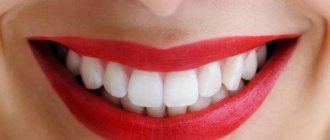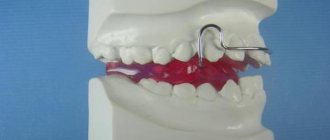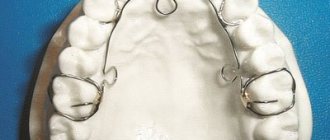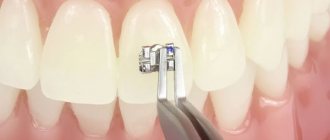Silicone braces system is a completely transparent mouth guard made of dental silicone, which is worn over the entire dentition. Its main distinguishing features from similar dental structures are: a gentler effect on the teeth and significantly less discomfort when wearing.
In addition, this is an excellent option for those patients who are embarrassed to wear metal braces.
Advantages of silicone braces
· Silicone braces are practically invisible, which indicates a high aesthetic value. They are very thin and completely transparent. They can only be seen upon very close examination.
· Individual production of mouth guards based on previously taken dental impressions exactly follows the contours of the dentition and guarantees a tight fit. Thus, the structure will not be able to move or fall out at the most unexpected moment.
· Getting used to silicone braces is quick; the patient does not experience any discomfort while wearing them.
· The design does not have sharp edges or elements that could injure the oral mucosa or tooth enamel.
· Dental silicone is a hypoallergenic material. In addition, it is very durable and resistant to any negative external influences, except hot food and drinks.
· Silicone braces are suitable for correcting malocclusion for both children and adults up to forty years of age, provided that they are not allergic to this material.
· Easy care of the mouthguard and oral cavity. The design does not complicate or interfere with proper hygiene. It can be easily and quickly removed before brushing your teeth or eating.
Purpose
Dental silicone is necessary to protect the delicate skin of the lips, tongue and cheeks from the traumatic effects of sharp clasps and braces. Silicone is an excellent alternative to previously used wax. What is the essence of its use? It is enough to take a small piece of the product and apply it with your fingers to the protruding structural elements. First, the material should be slightly heated and softened in your hands.
In many ways, the invasiveness of braces depends on the specific dental anomaly that they are designed to combat. This is also influenced by the individual characteristics of the patient’s jaw structure. The greatest inconvenience is caused by brackets installed to correct protrusion, that is, teeth that protrude strongly forward.
With retrusion, the risk of injury is much less, but during the adjustment period it is still better to use silicone for protection. It is produced in the form of small round plates. For one application, it is enough to pinch off just a little material, so its consumption is minimal. Some manufacturers produce silicone in convenient tubes.
Disadvantages of silicone braces
· Due to the high cost of the dental structure, not all patients can afford to have it installed. During the course of therapy, the design will have to be changed more than once. As a result, the cost of treatment increases significantly.
· Due to the milder effect on the body, treatment with silicone braces takes a little longer than with other structures of a similar purpose.
· The material is very sensitive to high temperature and under its influence the mouth guard can become deformed.
· When wearing it, careful and complete oral care is required, especially before each time the mouth guard is put on.
· Before the first installation of the structure, a thin layer of composite material is applied to the teeth, which is removed only after completion of treatment.
· The mouth guard has a very limited list of indications. Silicone braces cannot solve serious dental problems.
Moving teeth in orthodontics
When treating various defects of the dental system, the method of moving individual teeth or a group is often used. For this purpose, special springs are used, divided into several groups.
Types of orthodontic springs:
1. Serpentine - vestibular teeth move body-wise or around an axis.
2. Finger-shaped - used for corpus vestibular movement.
3. Hand-shaped - provide effective mesio-distal movement of individual teeth, mainly frontal ones.
4. With a round crossed curl - used for mesio-distal movement.
5. Oval spring in orthodontics
designed to move a group of cutters.
Indications for wearing silicone braces
There is no strict age limit for wearing silicone braces. Their help is resorted to in cases where other types of braces are simply not suitable for certain reasons. However, it should be taken into account that in patients aged forty years and older, the skeletal system has already formed and is highly durable. Therefore, it will no longer make sense for them to wear silicone braces.
Silicone structures are used in the following situations:
· if patients are allergic to the materials from which other braces and structures are made to correct the bite and straighten the dentition;
Shy children for whom wearing metal braces causes severe stress;
· public figures - teachers, lecturers, actors, politicians, for whom looking perfect is their main priority;
· when it is necessary to straighten the dentition after an injury or reconstructive maxillofacial surgery, as well as when constant access to the wound surface is needed for treatment.
However, silicone braces cannot help eliminate gaps, severely crooked or misaligned teeth, or pull out an unerupted tooth. They are only suitable for use in cases of minor deviation from the norm. Severe defects will have to be eliminated with more serious dental structures.
What are they and for what purposes are they installed?
What are retainers after braces ? This is the name of a type of orthodontic splint that is worn during the retention period. This is the time when the tooth tends to return to its original position. The retainer prevents curvature until the bite becomes permanent.
A return to the incorrect position of the teeth in the mouth occurs due to the peculiarities of their structure. The fact is that in addition to the usual position, the tooth has a ligamentous apparatus. The ligaments are much more conservative than the bite itself; they strive to return everything to the way it was. It takes a lot of time to retrain ligaments and muscles. Orthodontic retainers help fight muscle memory, which tends to ruin your teeth again.
Until recently, doctors believed that after correcting the bite, teeth remain straight for life. Today it has been proven that this is a myth.
Treatment regimen with silicone braces
Treatment using silicone braces takes place in several stages. At the initial examination, the doctor directs the patient to take an x-ray, after which he determines the advisability of using silicone braces.
Next, he selects the required type of mouthguards, which can be either standard or individual. The first option is not suitable for everyone and is considered less effective. Therefore, in most cases, the patient is offered to make an individual model, taking into account all the features of his oral cavity.
With the patient's consent, the dentist takes an impression of the teeth. Next, in a dental laboratory, using computer modeling, they recreate a 3D model of the dentition and send it to a company that produces silicone braces.
Manufacturers will make 20-30 different sets of mouth guards. Their exact number will depend on the severity of the dental problem.
After fitting, the doctor applies a composite material to the surface of the teeth. In addition, he will definitely give recommendations on wearing and caring for silicone braces.
The patient wears one aligner for about two weeks, after which he changes it to a new one. The course of treatment is approximately six months to two years. Its duration depends on the complexity of the case.
Reviews
Reviews about the device are mixed. For some people, the composition is ideal, so addiction occurs quickly. Other patients respond negatively and believe that the use of strips is not necessary.
More often, patients complain about poor compliance of the material. It is quite hard, so it is difficult to spread it over the teeth.
So that the user can understand whether he needs to purchase the product or not, he reads reviews. Therefore, below is a section where every person, a site visitor who has used silicone plates, can leave them.
If you find an error, please select a piece of text and press Ctrl+Enter.
Tags: braces vestibular braces
Did you like the article? stay tuned
Previous article
Unique possibilities of hirudotherapy in dentistry
Next article
What makes ODP braces different from other systems?
Proper care of silicone braces
To get the best results from the treatment, you must follow all the rules for caring for the silicone structure:
· Before each meal and before brushing your teeth, the aligner must be removed.
· Before putting it back on, you should thoroughly brush your teeth using toothpaste, mouthwash and floss.
· Store silicone braces in a special container, which is included with the aligners.
In addition, the patient must regularly wear the silicone structure and follow all the dentist’s recommendations. Otherwise, treatment may be delayed indefinitely. If you experience the slightest problem with your mouth guard, you should immediately contact a specialist.
Preparing for positioning
Fixing braces requires preparation. First, the patient will have an initial consultation with an orthodontist. After this, the dentist will prepare the oral cavity for attaching corrective structures.
Installation of braces is allowed only on healthy elements of the jaw arch. Preparation consists of several stages:
- Treatment of caries. It is necessary to detect carious lesions, even the smallest ones, and eliminate them.
- Checking installed seals. If your teeth were filled a long time ago, you need to check the strength of the old linings. If necessary, replace with new ones.
- Treatment of periodontal disease. The oral mucosa must be absolutely healthy. Therefore, even minor inflammatory processes can worsen after the installation of braces. We need to eliminate them.
- Remineralization. If the enamel on the teeth is thinned, the units are sensitive or there are cracks on them, it is necessary to carry out remineralization and strengthen the enamel.
Preparation for attaching braces, depending on the condition of the oral cavity, can last up to several months. During orthodontic therapy, it is necessary to take panoramic photographs of the dental system. Using them, the dentist will draw up a treatment plan and determine where to fix the locks. Before carrying out the bonding procedure, you need to make an appointment for professional teeth cleaning. The purpose of this dental service is to remove tartar and plaque. The braces should be fixed to a clean surface of the teeth. During fastening, nothing should interfere with gluing the structure.
How much do silicone braces cost?
The price of a silicone dental structure may vary somewhat. It depends on the material used and manufacturing technology. Moreover, the cost of standard models is quite affordable, while the price of individual silicone mouth guards is much higher.
Now there are many companies that make silicone mouth guards. But since this dental design is the development of American doctors, original models can only be made in clinics that have a special license.
Comparison with wax
Silicone is a good alternative to classic dental wax, and in some respects even superior to it. Although in terms of the totality of qualities these are quite comparable materials.
Some comparative characteristics of wax and silicone
| Parameter | Wax | Silicone | Note |
| Ease of application and removal | Similar | Similar | Reviews from some patients note that silicone requires more time to knead and warm up than wax |
| Fastening strength | Lower than silicone | Higher than wax | — |
| Duration of use of one application | The same | The same | — |
| Fabric compatibility, hypoallergenic | Similar | Similar | — |
| Price | About the same | About the same | — |











